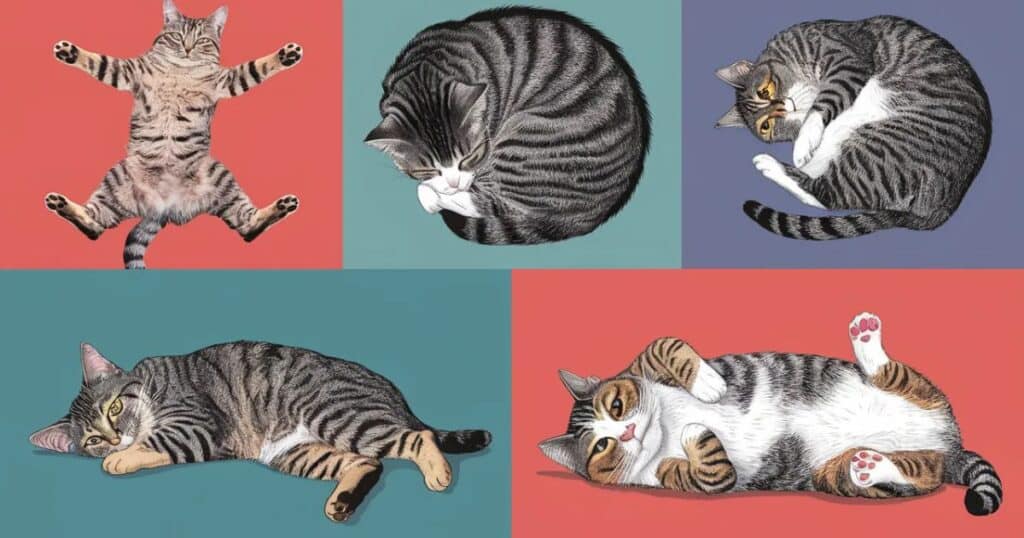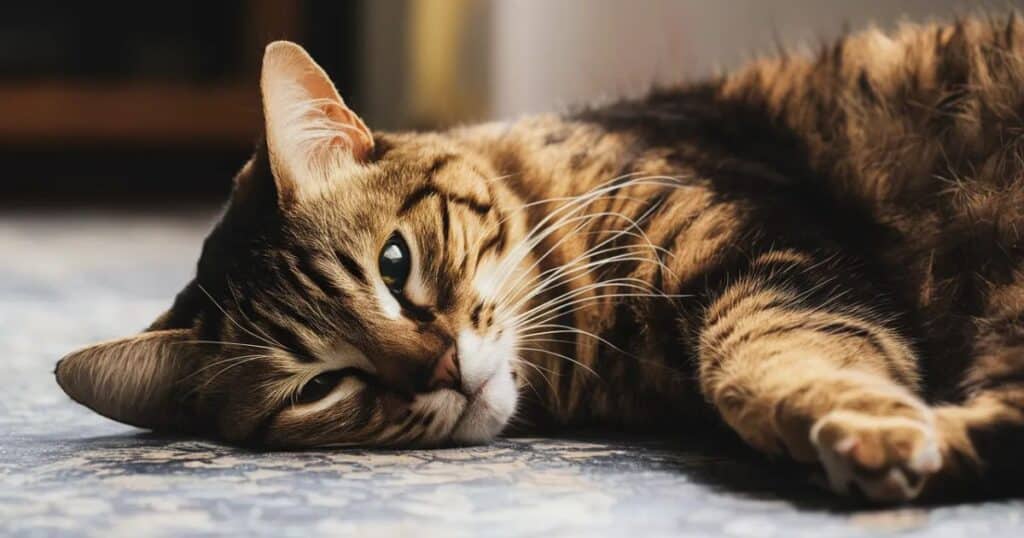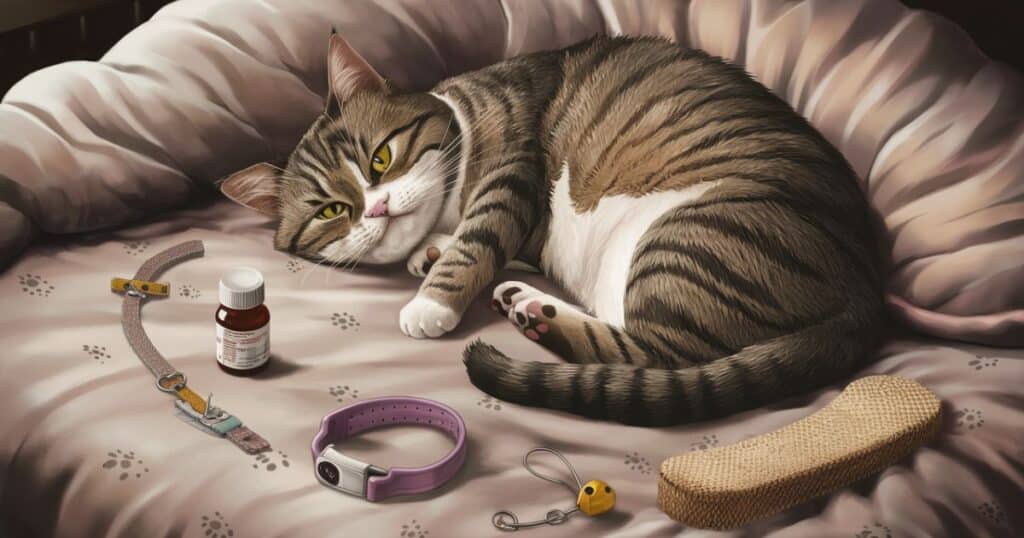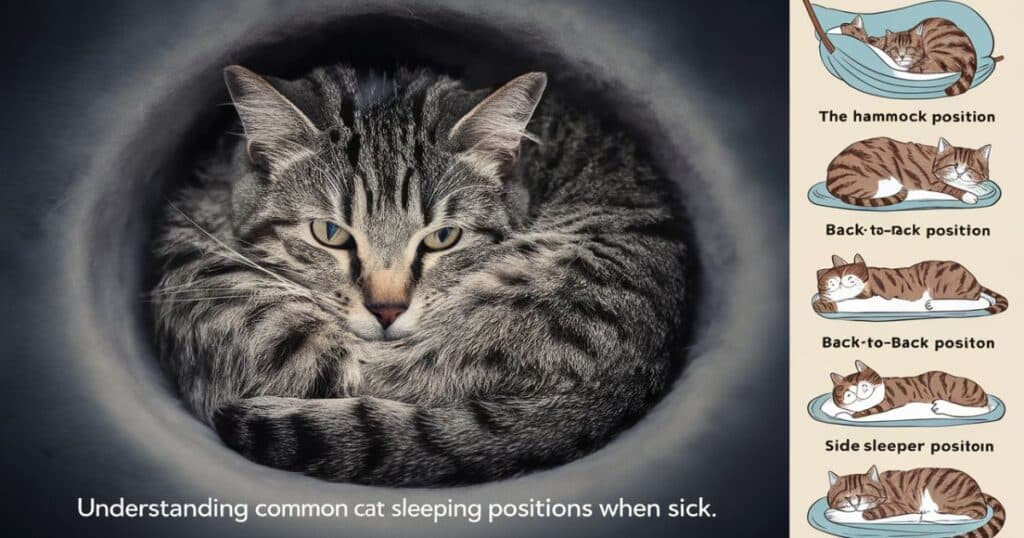As cat owners, we’ve all witnessed our feline friends napping in various positions, from curled up tightly to sprawled out on their backs. While these sleeping poses may seem adorable, they can also provide valuable insights into our cats’ health and well-being, especially when they’re feeling under the weather.
In this comprehensive guide, we’ll dive into the world of feline slumber, exploring common cat sleeping positions when sick and what they could mean. By understanding these subtle cues, you’ll be better equipped to recognize signs of illness and provide the necessary care for your furry companion.
Common Cat Sleeping Positions When Sick and Their Meanings

Cats are masters of communication, and their sleeping positions can reveal a great deal about their physical and emotional state. When your feline friend is feeling unwell, you may notice changes in their typical sleeping patterns and postures. Here are some common sleeping positions to watch out for and what they could indicate:
- Curled up tightly in a ball: This compact position, with the head tucked towards the body and the tail wrapped around, is a classic cat sleeping pose. However, when a sick cat assumes this position, it could be a sign that they’re experiencing pain, fever, or general discomfort. By curling up tightly, they’re trying to conserve body heat and protect themselves from potential threats or disturbances.
“When my cat Bella was recovering from a bout of pancreatitis, she would often curl up into a tiny ball,” shares Sarah, a cat owner from New York. “It was as if she was trying to make herself as small as possible, almost like she was hiding from the discomfort she was feeling.” - Stretched out flat on their side: A cat stretched out flat on their side, with their legs extended and their body taking up more space, could be a sign of lethargy or weakness. This position may indicate that your feline friend lacks the energy to maintain a more upright or curled-up posture, potentially due to an underlying illness or fatigue.
“After Simba’s dental surgery, he would sleep stretched out on his side for hours,” recalls Emily from Los Angeles. “It was like he didn’t have the strength to move or curl up into his usual cozy ball.” - Hunched position: If you notice your cat sleeping in a hunched position, with their back arched and their head lowered towards their chest, it could be a sign of respiratory issues, such as asthma, bronchitis, or congestion. This posture may help alleviate discomfort in the chest area and make it easier for them to breathe.
- Head tucked under the body: When a cat tucks their head under their body while sleeping, it could be a way of hiding signs of illness or discomfort. This position may also help them feel more secure and protected, as if they’re trying to block out any potential disturbances or stimuli that could exacerbate their condition.
- Elevated sleeping spot: If your cat starts seeking out elevated sleeping spots, such as the top of a cat tree, a high shelf, or the back of a couch, it could be a sign of respiratory issues or congestion. The elevated position may help them breathe more easily by allowing for better airflow and drainage.
- Sleeping more than usual: While cats are known for their love of napping, excessive sleeping or lethargy that deviates significantly from their typical patterns could be a sign that your feline friend is fighting off an illness and conserving energy for recovery.
It’s important to note that these sleeping positions alone may not necessarily indicate illness, but when combined with other symptoms or changes in behavior, they can provide valuable clues about your cat’s health.
MORE POST: Do Maine Coon Cats Shed? – The Ultimate Guide To Managing Their Magnificent Coats
Do Resting And Sleeping Positions Matter?
Absolutely! Paying attention to your cat’s sleeping positions and any changes in their typical patterns can be crucial in recognizing potential health issues. Cats are experts at masking signs of illness, and their sleeping positions may be one of the few outward indicators that something is amiss.
Specific sleeping positions can be linked to certain types of discomfort or illnesses. For example, a hunched position may suggest respiratory problems, while a curled-up posture could indicate pain or fever. By tracking these positional changes over time, you can better identify patterns and determine when it’s time to seek veterinary care.
Dr. Emily Parker, a feline veterinarian based in Chicago, emphasizes the importance of paying attention to sleeping positions: “Cats are incredibly stoic animals, and they often hide their discomfort or illness until it becomes severe. Their sleeping positions can be one of the first clues that something isn’t quite right, so it’s crucial for owners to be observant and take note of any deviations from their cat’s normal behavior.”
Recognizing Signs of Sickness through Sleeping Positions
While sleeping positions can provide valuable clues, it’s important to be aware of other signs of illness that may accompany these postures. Here are some common symptoms to watch out for:
- Lack of energy and excessive sleep: If your normally active cat suddenly seems lethargic and is sleeping more than usual, it could be a sign of an underlying health issue. Monitor their energy levels and sleep duration, as prolonged lethargy can be a cause for concern.
- Loss of appetite: A decreased interest in food or water can be a concerning symptom, as it may indicate digestive problems, dental issues, or other illnesses. Cats are known to be finicky eaters, but a complete loss of appetite should not be ignored.
- Vomiting or diarrhea: These gastrointestinal symptoms can be signs of various illnesses, ranging from food intolerances or parasites to more serious conditions like inflammatory bowel disease or pancreatitis.
- Signs of pain: If your cat appears to be in discomfort, vocalize excessively, have difficulty moving, or exhibit changes in their litter box habits, it could be a sign of an injury, arthritis, or chronic condition.
- Anxiety or hiding: Cats may exhibit anxious behavior, such as excessive grooming, pacing, or seeking out hiding spots, when they’re not feeling well. This behavior can be a way for them to feel more secure and protected.
- Changes in grooming habits: A decrease in self-grooming or an unkempt appearance can be an indicator of illness, pain, or discomfort, as cats typically take great pride in their grooming routines.
Visuals and examples can be powerful tools in recognizing these signs of sickness. Refer to the following images to better understand what to look out for:
By being observant and recognizing these signs in conjunction with changes in sleeping positions, you’ll be better equipped to identify potential health issues and seek appropriate care for your feline companion.
Common Illnesses and Their Impact on Sleeping Positions
Many common feline illnesses can manifest in changes to your cat’s sleeping positions and behaviors. Here are some examples:
- Urinary tract infections (UTIs): Cats with UTIs may exhibit discomfort or pain, leading them to adopt a curled-up or hunched sleeping position. They may also have difficulty getting comfortable and frequently change positions.
- Respiratory issues: Conditions like asthma, bronchitis, or upper respiratory infections can cause breathing difficulties, prompting cats to seek elevated sleeping spots or assume a hunched posture to aid in easier breathing.
- Digestive problems: Issues like inflammatory bowel disease (IBD), pancreatitis, or constipation can cause discomfort and lethargy, affecting your cat’s sleeping patterns and positions. They may curl up tightly or sleep more frequently to conserve energy.
- Dental disease: Painful dental conditions, such as gingivitis, tooth abscesses, or oral tumors, can make it uncomfortable for cats to eat or groom, leading to changes in their sleeping habits and positions as they try to avoid aggravating the discomfort.
- Arthritis and joint pain: As cats age, they may develop arthritis or other joint-related issues, causing them to sleep in more compact positions or avoid jumping onto elevated surfaces due to pain or stiffness.
- Neurological disorders: Conditions like feline cognitive dysfunction (FCD) or brain tumors can impact a cat’s sleep patterns, behavior, and overall comfort levels, leading to changes in their sleeping positions and habits.
- Kidney disease: Cats with kidney disease may experience discomfort, lethargy, and changes in their sleeping patterns and positions as the disease progresses.
- Cancer: Depending on the type and location of cancer, cats may experience various symptoms that can affect their sleeping positions and behaviors. For example, tumors in the abdomen or chest cavity may cause discomfort or difficulty breathing, leading to changes in sleeping postures.
It’s essential to note that while these sleeping positions can provide clues about potential health issues, they should not be used as a sole diagnostic tool. If you notice persistent changes in your cat’s sleeping habits or positions, it’s best to consult with a veterinarian for proper diagnosis and treatment.
Monitoring and Recording Cat Sleeping Positions

To better understand your cat’s sleeping patterns and identify potential health concerns, it can be helpful to monitor and record their sleeping positions regularly. Here are some tips:
- Observe day and night: Cats are naturally more active at dawn and dusk, so it’s important to observe their sleeping positions during both day and night to get a comprehensive picture of their habits.
- Keep a sleep journal: Note down the time, duration, and specific sleeping position your cat assumes, along with any other symptoms or behaviors you observe. This can help you identify patterns or deviations from their normal routines.
- Use visual aids: Take photos or videos of your cat’s sleeping positions to help track changes over time and share with your veterinarian if needed. Visual documentation can be especially helpful in capturing subtle differences or nuances in their postures.
- Look for patterns: Pay attention to any patterns or deviations from your cat’s typical sleeping habits, as these could be indicators of an underlying issue. For example, if your cat suddenly starts sleeping in an elevated spot or curling up more tightly, it could signal discomfort or illness.
- Consider environmental factors: Note any changes in your cat’s environment, such as new household members, renovations, or relocations, as these can potentially affect their sleeping patterns and behaviors.
By consistently monitoring and recording your cat’s sleeping positions and behaviors, you’ll be better equipped to spot early signs of potential health concerns and take appropriate action.
Creating a Comfortable Environment for Sick Cats
When your feline friend is feeling under the weather, creating a comfortable and supportive environment can aid in their recovery and alleviate discomfort. Here are some tips:
- Provide cozy, quiet spaces: Offer your sick cat a warm, quiet area to rest, away from noise, foot traffic, and other potential disturbances. Soft bedding, familiar scents, and low lighting can help them feel secure and relaxed.
- Easy access to food and water: Place food and water bowls in close proximity to your cat’s resting area to encourage hydration and nutrient intake without excessive movement. Consider using elevated bowls or placing them on a stable surface to make it easier for your cat to eat and drink.
- Keep areas clean: Regularly clean your cat’s sleeping areas and litter boxes to maintain a hygienic environment and minimize stress or discomfort. Use gentle, unscented cleaning products to avoid overwhelming your cat’s sensitive sense of smell.
- Temperature regulation: Ensure your cat’s resting area is neither too hot nor too cold, as temperature extremes can exacerbate certain illnesses or discomfort. Provide cozy blankets or heating pads (on low settings) for added warmth, or consider using a fan or air conditioning if the area is too warm.
- Offer familiar toys and perches: Familiar toys, scratching posts, and elevated perches can provide comfort and a sense of normalcy for your sick cat, even if they don’t have the energy to play or climb actively.
- Minimize disturbances: Try to limit loud noises, sudden movements, or other potential disturbances near your cat’s resting area, as these can cause stress and disrupt their much-needed rest.
By creating a comfortable and supportive environment tailored to your cat’s specific needs, you can help alleviate their discomfort and promote healing during times of illness.
Home Care for Cats with Sleep-related Illnesses
If your cat is exhibiting signs of illness or discomfort through their sleeping positions and behaviors, there are certain home care measures you can take to help alleviate their symptoms and promote recovery:
- Gentle handling: When interacting with a sick cat, be gentle and avoid sudden movements or loud noises that could startle or stress them further. Speak softly and approach them calmly, allowing them to initiate contact when they’re ready.
- Encouraging hydration and nutrition: Proper hydration and nutrition are essential for recovery. You can entice your cat to eat and drink by offering their favorite foods, trying different textures (e.g., wet food or broths), or warming up their meals to enhance the aroma. However, if your cat is not eating or drinking for an extended period, seek veterinary advice promptly.
- Pain management options: If your cat appears to be in pain, consult with your veterinarian about safe over-the-counter pain medication options or other remedies that can provide relief. Never give your cat human medications without explicit veterinary guidance, as they can be toxic and potentially life-threatening.
- Supplemental care: Depending on your cat’s condition, your veterinarian may recommend supplemental care options, such as fluid therapy, syringe feeding, or administering medication. Follow their instructions carefully and seek guidance if you’re unsure about any aspect of your cat’s care.
- When to seek veterinary care: While some minor illnesses can be managed at home, it’s essential to seek professional veterinary care if your cat’s symptoms persist or worsen, or if they exhibit signs of severe distress or pain. Prolonged loss of appetite, lethargy, vomiting, or diarrhea are all indications that your cat needs prompt medical attention.
Remember, home care should be considered a supportive measure, and it’s crucial to work closely with your veterinarian to ensure your cat receives the appropriate treatment and monitoring for their specific condition.
Seeking Veterinary Care and Professional Advice
In many cases, home care may not be enough, and it’s crucial to seek professional veterinary care for your sick cat. Here are some signs that warrant a visit to the vet:
- Prolonged loss of appetite or refusal to eat or drink
- Persistent vomiting or diarrhea
- Difficulty breathing or respiratory distress
- Lethargy or weakness that doesn’t improve
- Signs of severe pain or discomfort
- Sudden changes in behavior or sleeping patterns
- Unexplained weight loss or gain
- Abnormal discharge or bleeding
When visiting the veterinarian, be prepared to provide a detailed history of your cat’s symptoms, including changes in sleeping positions and behaviors, as well as any observations you’ve recorded. Your veterinarian may recommend diagnostic tests, such as blood work, imaging (e.g., X-rays or ultrasounds), or other procedures to determine the underlying cause of your cat’s illness.
Based on the diagnosis, your veterinarian will develop a treatment plan tailored to your cat’s specific needs. This may include medications, dietary changes, or other therapies, such as fluid therapy or supplemental care. It’s essential to follow your veterinarian’s instructions carefully and monitor your cat’s progress closely, reporting any changes or concerns promptly.
In some cases, your veterinarian may recommend hospitalization or specialized care if your cat’s condition requires more intensive treatment or monitoring. While this can be difficult for both you and your feline companion, it’s important to prioritize their health and well-being.
Don’t hesitate to ask your veterinarian questions or seek clarification on any aspect of your cat’s care. A good veterinarian will be happy to explain the diagnosis, treatment options, and what to expect during the recovery process.
Preventative Measures for Cat Health and Sleeping Positions

While illness is sometimes unavoidable, there are preventative measures you can take to promote your cat’s overall health and well-being, which may help minimize the occurrence of sleep-related issues:
- Proper diet and weight management: Providing a balanced, high-quality diet and maintaining a healthy weight can reduce the risk of obesity-related health issues and ensure your cat receives the necessary nutrients for optimal health. Consult with your veterinarian to determine the appropriate diet and portion sizes for your cat’s age, activity level, and any specific dietary needs.
- Regular veterinary check-ups: Routine wellness exams and preventative care, such as vaccinations, parasite control, and dental cleanings, can help detect and address potential health concerns early on before they become more serious.
- Grooming and hygiene: Regular grooming and maintaining a clean living environment can help prevent skin and coat issues, as well as reduce the risk of infections or other health problems. Brush your cat regularly, trim their nails, and keep their living spaces clean and well-maintained.
- Environmental enrichment: Providing mental and physical stimulation through playtime, interactive toys, and environmental enrichment (e.g., cat trees, scratching posts) can help alleviate stress and promote overall well-being, which can positively impact your cat’s sleep quality and general health.
- Dental care: Proper dental care, including regular teeth brushing and professional cleanings, can help prevent painful dental issues that could lead to changes in your cat’s sleeping positions and behaviors.
- Parasite control: Fleas, ticks, and other parasites can not only cause discomfort but also transmit diseases that can affect your cat’s overall health and sleep patterns. Consult with your veterinarian about effective parasite prevention and control measures.
- Stress management: Cats can be susceptible to stress, which can weaken their immune systems and make them more prone to illness. Identify and address potential sources of stress in their environment, such as loud noises, unfamiliar people or animals, or changes in routine.
- Regular exercise: Providing opportunities for safe, controlled exercise and playtime can help keep your cat physically and mentally stimulated, which can contribute to better sleep quality and overall health.
By prioritizing preventative care and maintaining a healthy lifestyle for your feline companion, you may be able to reduce the likelihood of illnesses that could disrupt their normal sleeping patterns and behaviors.
Understanding Cat Sleep Cycles and Behavior
To better interpret your cat’s sleeping positions and behaviors, it’s helpful to understand their natural sleep cycles and habits:
- Sleep needs: Cats tend to sleep between 16 and 20 hours per day, with kittens and senior cats often requiring even more rest. However, these hours are typically broken up into multiple naps throughout the day and night.
- Polyphasic sleeping patterns: Unlike humans, cats have a polyphasic sleep cycle, meaning they take multiple naps throughout the day and night rather than sleeping in one continuous stretch. This pattern is believed to be an evolutionary adaptation to their natural hunting behaviors.
- Sleep sounds and movements: Cats may exhibit various behaviors during sleep, such as twitching their legs or tails, making soft vocalizations, or even appearing to be chasing prey in their dreams. These are generally normal and not cause for concern unless accompanied by other signs of distress or abnormal movements.
- Age and activity level: A cat’s sleep patterns and positions can also be influenced by their age and activity level. Kittens and senior cats may sleep more due to their higher energy requirements and lower activity levels, while active, indoor-outdoor cats may have more varied sleeping habits.
- Circadian rhythms: Like humans, cats have natural circadian rhythms that influence their sleep-wake cycles. They tend to be more active and alert during dawn and dusk, which are their natural hunting times in the wild.
By understanding these natural sleep cycles and behaviors, you’ll be better equipped to differentiate between normal sleep patterns and potential signs of illness or discomfort.
Case Studies: Cat Sleeping Positions and Illnesses
To further illustrate how sleeping positions can be indicators of specific health issues, let’s examine a few case studies:
- Lily, a 3-year-old domestic shorthair: Lily’s owner noticed that she had been sleeping more than usual and was often found curled up tightly in a ball. Upon closer observation, Lily also seemed to be grooming less and had lost some weight. After a visit to the veterinarian, Lily was diagnosed with inflammatory bowel disease (IBD), which was causing her discomfort and lethargy. With proper treatment, including a specialized diet and anti-inflammatory medication, Lily’s sleeping patterns gradually returned to normal.
- Oscar, a 10-year-old Maine Coon: As Oscar entered his senior years, his owner noticed that he was increasingly sleeping in a hunched position and seemed to have difficulty breathing at times. Additionally, Oscar had been seeking out elevated sleeping spots, such as the back of the couch or the top of a cat tree. After a thorough examination, the veterinarian diagnosed Oscar with feline asthma, a common respiratory condition in cats. With appropriate medication, including bronchodilators and corticosteroids, and environmental modifications (e.g., air purifiers), Oscar’s breathing improved, and he was able to sleep more comfortably.
- Luna, a 5-year-old Bengal: Luna’s owner noticed that she had been sleeping more than usual and often sought out elevated spots, such as the top of a bookshelf or the back of the couch. Additionally, Luna seemed to be sneezing and had a runny nose. After a visit to the vet, Luna was diagnosed with an upper respiratory infection, likely caused by a viral or bacterial pathogen. Her elevated sleeping positions likely helped her breathe more easily. With antibiotics, anti-inflammatory medication, and rest, Luna’s symptoms cleared up, and her sleeping habits returned to normal.
- Simba, a 12-year-old domestic shorthair: Simba’s owner noticed that he had been sleeping stretched out flat on his side for extended periods, which was unusual for him. Additionally, Simba seemed to be vocalizing more than usual and was having difficulty getting comfortable in his usual sleeping spots. After a visit to the veterinarian, Simba was diagnosed with osteoarthritis, a common condition in older cats that causes joint pain and stiffness. With pain management medication, supplements, and adjustments to his sleeping environment (e.g., orthopedic beds, ramps), Simba’s discomfort was alleviated, and he was able to sleep more comfortably.
These case studies demonstrate how changes in sleeping positions can be linked to specific health conditions and how addressing the underlying issue through proper treatment and environmental modifications can help restore a cat’s normal sleeping patterns and overall well-being.
Conclusion
As cat owners, being attuned to our feline companions’ sleeping positions and behaviors can provide valuable insights into their health and well-being. By understanding the common sleeping positions that sick cats may assume, such as curling up tightly, stretching out flat, or assuming a hunched posture, you can better recognize potential signs of illness or discomfort.
However, it’s essential to remember that sleeping positions alone should not be used as the sole diagnostic tool. They should be considered in conjunction with other symptoms, such as changes in appetite, energy levels, grooming habits, or the presence of vomiting or diarrhea. Monitoring and recording your cat’s sleeping positions and patterns over time can help you identify deviations from their normal behavior and spot potential health concerns early on.
By creating a comfortable and supportive environment for your sick cat, providing appropriate home care when possible, and seeking professional veterinary care when necessary, you can help ensure your feline friend receives the care and attention they need during times of illness.
Implementing preventative measures, such as a balanced diet, regular exercise, and environmental enrichment, can also contribute to your cat’s overall health and well-being, potentially reducing the likelihood of illnesses that could disrupt their normal sleeping patterns and behaviors.
Remember, being an observant and attentive cat parent is key to recognizing signs of discomfort or illness early on. By decoding your cat’s sleeping positions and behaviors, you can take proactive steps towards maintaining their health and well-being, ensuring many more years of restful slumber and feline companionship.
ALSO READ THIS POST: Why Is My Cat Gulping While Purring?
FAQ’s
What is the position of a sick cat sleeping?
A sick cat may sleep curled up tightly in a ball, stretched out flat on their side, or in a hunched position, depending on the illness. These positions can indicate pain, lethargy, or respiratory issues.
What is a cat’s favorite sleeping position?
Most cats prefer sleeping curled up in a tight ball, with their head tucked towards their body and tail wrapped around them. This cozy position helps them conserve body heat and feel secure.
Do cats sleep when they are sick?
Yes, cats tend to sleep more than usual when they are sick as a way to conserve energy for recovery. Excessive sleeping or lethargy can be a sign of illness in cats.
Why do cats sleep in weird positions?
Cats may sleep in unusual or strange positions due to discomfort, pain, or respiratory issues. These positions can help alleviate their symptoms and make breathing or resting easier.
Do cats like tummy rubs?
Most cats do not enjoy tummy rubs, as their bellies are a vulnerable area. Petting a cat’s tummy can make them feel exposed and may trigger defensive behavior.
How to tell if a cat is in pain?
Signs that a cat may be in pain include vocalizing excessively, changes in sleeping positions or habits, decreased grooming, loss of appetite, and difficulty moving or getting comfortable.

Davin Connor is an experienced author with 3 years in pets writing. Known for concise, informative content, he shares expertise on pet care, behavior, and health through his engaging articles.






